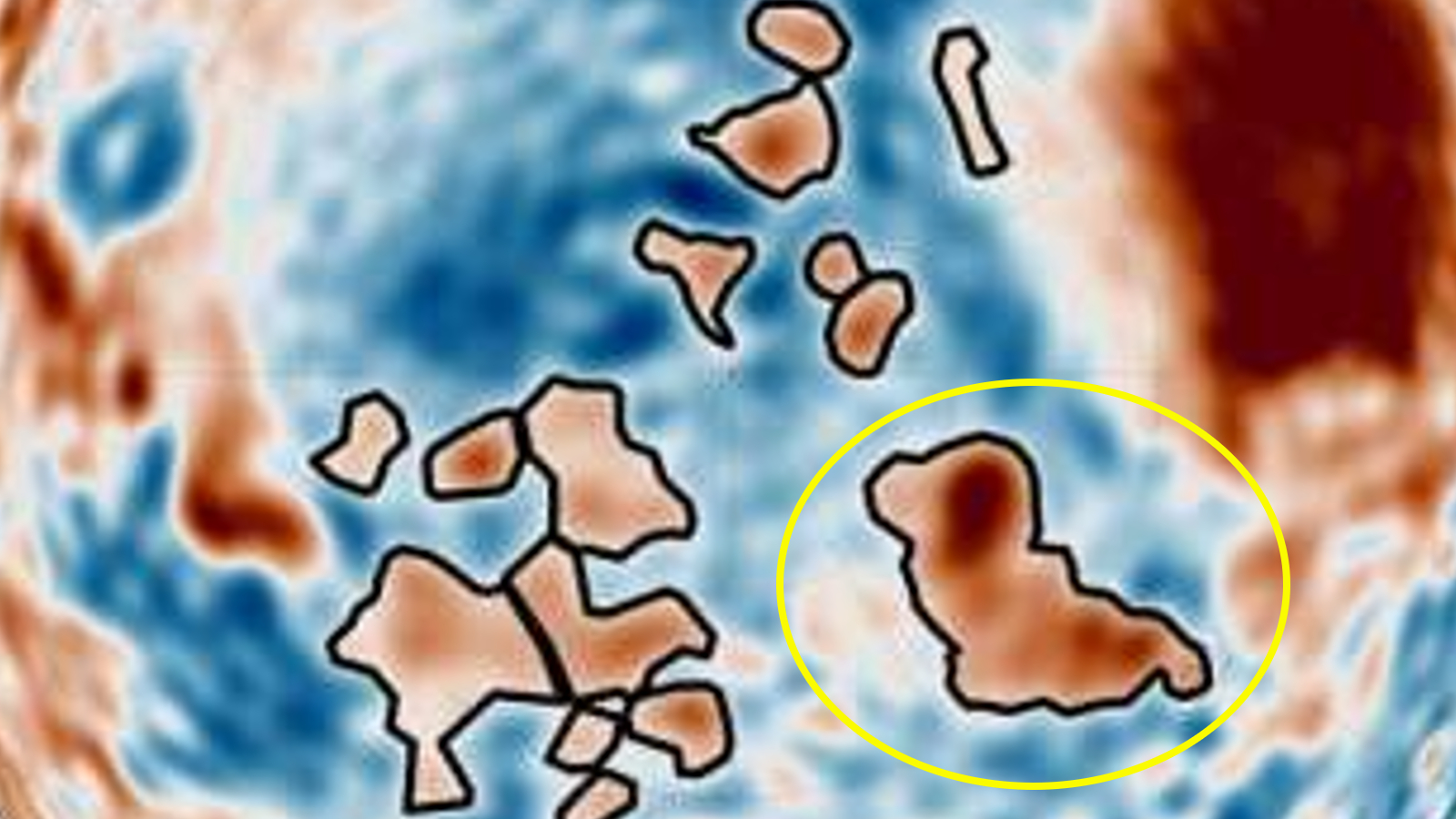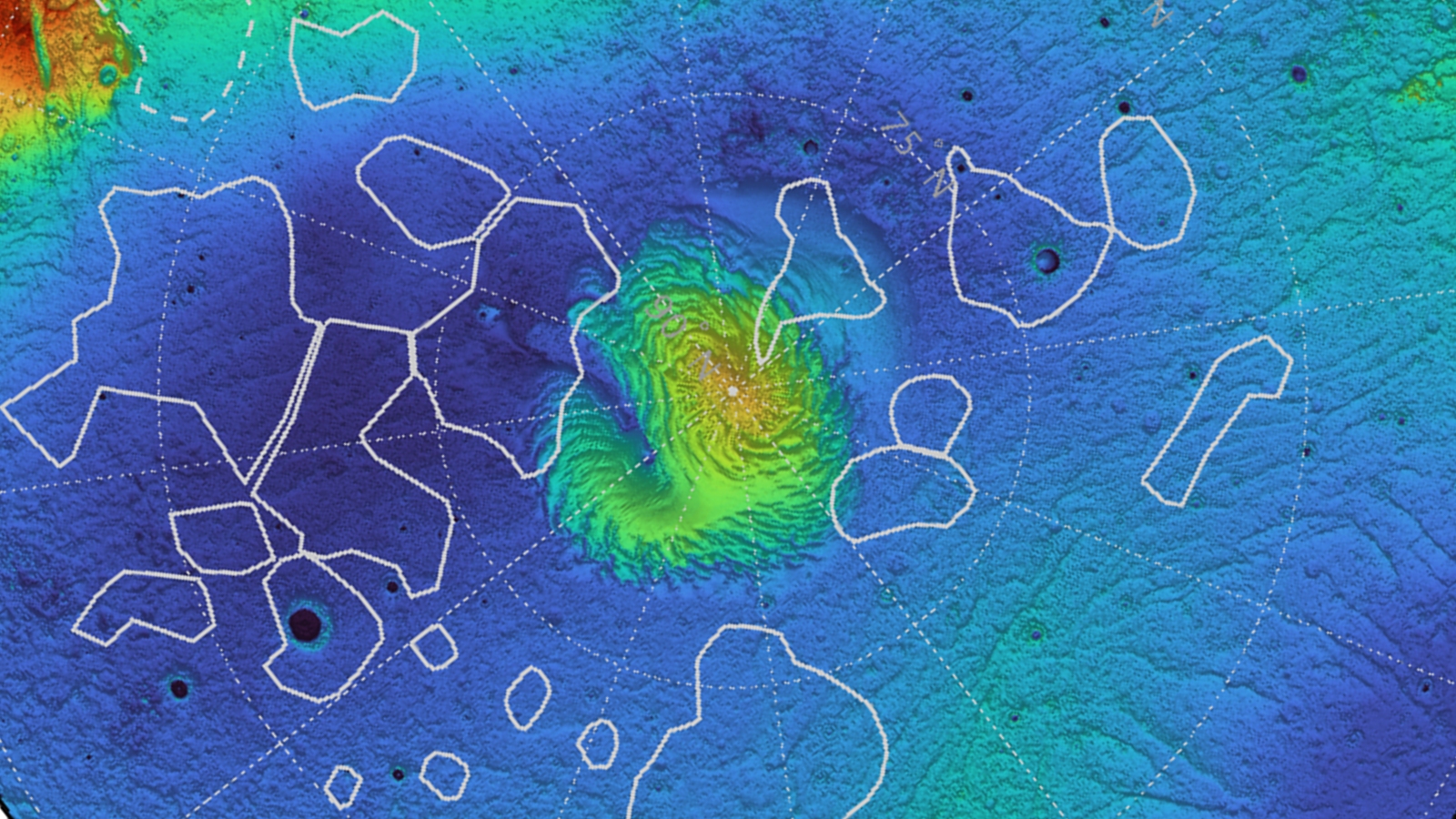'Martian dog' and dozens of other mysterious blobs found hiding under Mars' north pole in new 'gravity map'
A new map that details gravitational anomalies on Mars has revealed 20 mysteriously dense blobs, including a dog-shaped mass, buried below the planet's north pole. And researchers have no clear idea where they came from.

Dozens of mysteriously dense blobs — including one surprisingly pooch-shaped structure — are lurking beneath an ancient seabed surrounding Mars' north pole, a new "gravity map" of the Red Planet reveals. The first-of-its-kind atlas also confirms a recent finding about Mars' tallest mountain that could help reveal secrets about the planet's volcanic past and present.
In a new study, researchers created the first true global density map of Mars by combining data about the planet's crust from NASA's InSight lander with records of fluctuations in the orbits of satellites, such as NASA's Mars Reconnaissance Orbiter and the European Space Agency's Mars Express, as they were pulled out of place by hidden gravitational anomalies.
The standout features in the new map were 20 underground blobs in the Borealis Basin in Mars' northern hemisphere, which was an ancient seabed more than 3 billion years ago. These blobs come in a range of shapes and sizes, including one that "resembles the shape of a dog," and have densities between 300 and 400 kilograms per cubic meter higher than the surrounding ground, the researchers wrote in a statement.
However, it is currently unclear what these blobs are, why they are so dense or how they were created.
"These dense structures could be volcanic in origin or could be compacted material due to ancient [meteor] impacts," study lead author Bart Root, a planetary scientist at Delft University of Technology in the Netherlands, said in the statement. And "there seems to be no trace of them at the surface," he added.
The team presented their findings at the Europlanet Science Congress, which was held in Berlin Sept. 8-13.
Related: 15 Martian objects that aren't what they seem
Sign up for the Live Science daily newsletter now
Get the world’s most fascinating discoveries delivered straight to your inbox.

The new map also confirmed the presence of a massive 1,100-mile-wide (1,750 kilometers) blob under Olympus Mons, a dormant volcano near Mars' equator that, at more than 16 miles (25 km) above the planet's surface, is the solar system's tallest mountain.
This gigantic blob, which was first detected in 2022, is less dense than its surroundings and is most likely a massive plume of cooled lava, hinting that Mars' volcanism may have ended only recently or could be ongoing.
The new map of the Olympus Mons blob could also shed light on the surrounding Tharsis plateau, an elevated region of Mars that is home to the planet's tallest volcanoes, as well as other intriguing geological structures, such as the recently mapped "Labyrinth of Night" canyon.
The newly mapped blobs are not the only interesting objects found under the Red Planet's surface recently.
In January, NASA satellites revealed a 2-mile-thick (3.2 km) layer of ice buried beneath Mars' equator. And in August, scientists announced the major discovery of an enormous hidden ocean — with enough water to cover the planet with 1 mile (1.6 km) of water — trapped deep below the Red Planet's surface.
The study authors are among a group of scientists proposing a Mars mission known as the Martian Quantum Gravity (MaQuls), which would fly twin spacecraft around the Red Planet, allowing researchers to more accurately measure concealed gravitational anomalies. The MaQuls mission was also recently discussed at the Europlanet Science Congress but has not been approved by any agency.

Harry is a U.K.-based senior staff writer at Live Science. He studied marine biology at the University of Exeter before training to become a journalist. He covers a wide range of topics including space exploration, planetary science, space weather, climate change, animal behavior and paleontology. His recent work on the solar maximum won "best space submission" at the 2024 Aerospace Media Awards and was shortlisted in the "top scoop" category at the NCTJ Awards for Excellence in 2023. He also writes Live Science's weekly Earth from space series.










